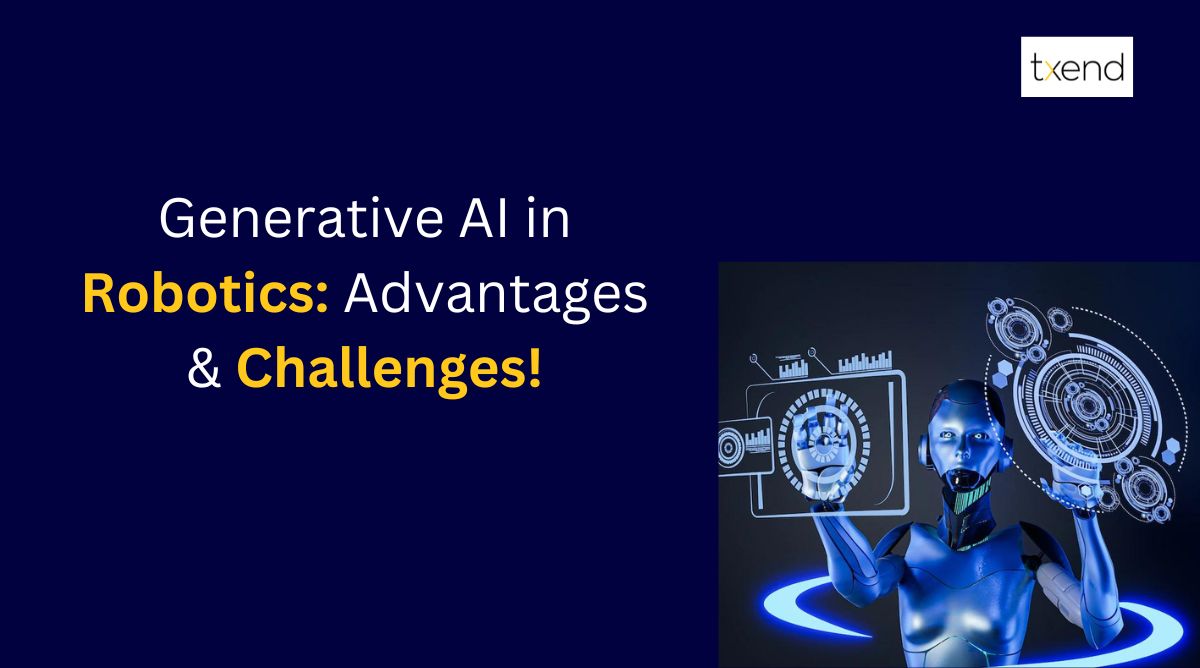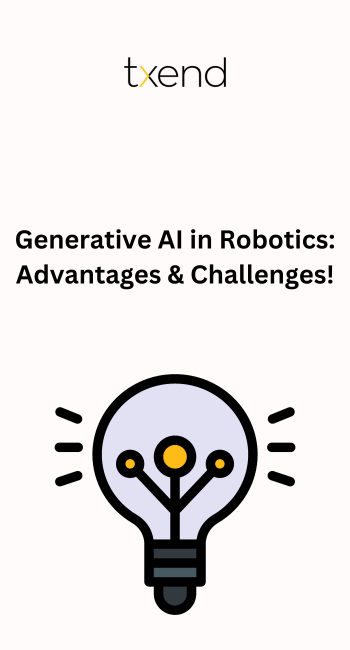
Generative AI is a powerful new technology that has the potential to revolutionize the field of robotics. By using generative AI to create new robotic designs, train robots, and generate synthetic data, we can create more intelligent, capable, and versatile robots than ever before.
The design of new robots is one of the most exciting uses of generative AI in robotics. With consideration for the robot’s intended use, surroundings, and limitations, generative AI may produce a vast array of possible robot designs.
This can help engineers to identify new and innovative robot designs that would be difficult or impossible to come up with using traditional methods.
Generative AI can also be used to train robots. By generating synthetic data, generative AI can create realistic training environments for robots. This can help robots to learn new skills and tasks more quickly and efficiently.
Lastly, artificial intelligence (AI) with generative capabilities can provide fake data to test and validate robotic systems. This can help engineers to identify and fix potential problems with robotic systems before they are deployed in the real world.
Generative AI In Robotics
All things considered, robots could be significantly impacted by generative AI. By using generative AI to design, train, and test robots, we can create more intelligent, capable, and versatile robots than ever before.
Generative AI in robotics is the use of generative AI techniques to create, design, train, and control robots. An artificial intelligence technique called generative AI can be used to produce new data, including text, graphics, and code.
This makes it ideal for use in robotics, as it can be used to create new robots, new designs for robots, and new training data for robots. Generative AI has several applications in the field of robotics.
Generative AI, for instance, can be utilized to:
Design New Robots:
Generative AI can produce a wide range of distinct robot designs depending on the required criteria. This can help engineers to identify new and innovative robot designs that would be difficult or impossible to come up with using traditional methods.
Train Robots:
Robots can be trained with synthetic data created by generative AI. This synthetic data can be used to create realistic training environments for robots, which can help them to learn new skills and tasks more quickly and efficiently.
Control Robots:
It is possible to create new robot control algorithms using generative AI. These control algorithms can be employed to provide robots the ability to carry out increasingly difficult jobs and more successfully adapt to changing circumstances.
All things considered, robots could be significantly impacted by generative AI. By using generative AI to design, train, and control robots, we can create more intelligent, capable, and versatile robots than ever before.
Applications
There are several applications of generative AI in robotics, such as
Robot Design:
By producing a wide range of distinct robot designs depending on the required criteria, generative AI can be utilized to build new robots.
This can help engineers to identify new and innovative robot designs that would be difficult or impossible to come up with using traditional methods.
Control Policies:
By producing a wide range of alternative control policies depending on the intended behavior of the robot, generative AI can be utilized to create novel control algorithms for robotics.
This can help engineers to develop control algorithms that are more efficient, robust, and adaptable to changing environments.

Path Planning:
Generative AI can be used to generate optimal paths for robots to follow. This can be useful for robots that need to navigate complex environments or that need to avoid obstacles.
Simulation And Testing:
Generative AI can be used to simulate robots and their environments. This can be useful for testing new robot designs and control algorithms in a safe and controlled environment.
Human-Robot Interaction:
By giving robots human-like behaviors and facial expressions, generative AI can create more effective and natural human-robot interactions.. This can make robots more engaging and more accessible to interact with.
Advantages And Disadvantages Of Generative Ai In Robotics
Advantages Of Generative AI In Robotics:
Faster And More Efficient Robot Design:
Depending on the required criteria, generative AI can produce a wide range of distinct robot designs. This can help engineers to identify new and innovative robot designs that would be difficult or impossible to come up with using traditional methods.
More Efficient And Robust Control Algorithms:
By producing a wide range of alternative control policies depending on the intended behavior of the robot, generative AI can be utilized to create novel control algorithms for robotics.
This can help engineers to develop control algorithms that are more efficient, robust, and adaptable to changing environments.
Optimal Path Planning:
Generative AI can be used to generate optimal paths for robots to follow. This can be useful for robots that need to navigate complex environments or that need to avoid obstacles.

Testing:
Generative AI can be used to simulate robots and their environments more realistically. This can be useful for testing new robot designs and control algorithms in a safe and controlled environment.
More Natural And Effective Human-Robot Interaction:
By giving robots human-like behaviors and facial expressions, generative AI can be utilized to create more effective and natural human-robot interactions.This can make robots more engaging and easier to interact with.
Disadvantages Of Generative AI In Robotics:
Computational Cost:
The cost of computing power to train and operate generative AI models can be high. This can make it difficult to use generative AI in real-time applications.
Data Requirements:
To train, generative AI models need a lot of data. This data can be difficult and expensive to collect and prepare.
Interpretability:
Models created by generative AI can be intricate and challenging to comprehend. This can make it difficult to identify and fix potential problems with the models.
Bias:
Generative AI models can be biased, depending on the data they are trained on. This bias can lead to the generation of robots that are biased or discriminatory.
Safety And Security:
Generative AI models could be used to generate malicious robots or to create deepfakes that could be used to deceive people.
All things considered, generative AI has the power to transform the robotics industry completely. However, it is important to be aware of the challenges and limitations of generative AI before using it in robotics applications.
Techniques
An artificial intelligence technique called generative AI can be used to produce new data, including text, graphics, and code. This makes it ideal for use in robotics, as it can be used to create new robots, new designs for robots, and new training data for robots.
There are a number of different generative AI techniques that can be used in robotics. Four of the most common techniques are:
Generative Adversarial Networks (GANs)
A generator and a discriminator are two competing networks that comprise a generative AI model called a GAN. While the discriminator is in charge of differentiating between produced and genuine data, the generator is in charge of producing new data.
Images, text, and code are just a few of the many forms of data that can be produced by GANs. They have been applied to creating artificial data for robot training, realistic facial photos, and novel robot designs.
Variationally Autoencoders (VAEs)
VAEs are another type of generative AI model that can be used to generate new data. VAEs work by encoding data into a latent space and then decoding the latent space to generate new data.
VAEs are particularly useful for generating synthetic data for training robots. This is because VAEs can learn the probability distribution of the data, which allows them to generate realistic samples of the data.

Reinforcement Learning (RL)
Using a sort of machine learning technique called reinforcement learning, agents can learn through trial and error how to act in a given situation. RL agents are typically rewarded for taking actions that lead to desired outcomes and penalized for taking actions that lead to undesired outcomes.
Robots can be trained to carry out tasks in a range of diverse contexts via reinforcement learning. For example, RL has been used to train robots to walk, run, climb, and navigate complex environments.
Evolutionary Algorithms (EAs)
EAs are a type of machine learning algorithm that is inspired by the process of evolution. EAs work by generating a population of candidate solutions and then iteratively improving the population by selecting and recombining the best candidate solutions.
EAs can be used to design robots by generating a population of robot designs and then iteratively improving the population by simulating the performance of the designs and selecting and recombining the best designs.
These are but a handful of the numerous robotics applications for generative AI approaches. We anticipate seeing even more ground-breaking and inventive uses of generative AI in robotics in the future as the technology develops.
Challenges And Future Directions
Generative AI in robotics is a cutting-edge technology that holds immense promise for revolutionizing the field. However, as with any emerging technology, it comes with its set of challenges and exciting future directions.
In this article, we’ll delve into the key challenges and potential pathways for the advancement of generative AI in robotics.
Challenges:
Scalability:
One of the primary challenges facing the integration of generative AI in robotics is scalability. As the complexity of robotic tasks and applications increases, so do the demands on generative AI algorithms.
Developing AI models capable of generating intricate and contextually relevant information in real-time can be computationally intensive.
This challenge is further exacerbated when considering scenarios where multiple robots must collaborate seamlessly. The future of generative AI in robotics will depend on addressing this scalability issue, making it feasible to deploy AI-powered robots in a wide range of settings.
Data Requirements:
Generative AI in robotics relies heavily on data to train and fine-tune models. Obtaining sufficient and diverse datasets that accurately represent real-world scenarios can be a significant challenge.
Moreover, data privacy and security concerns are increasingly relevant, making it imperative to find ways to train AI models while preserving sensitive information.
The future of generative AI in robotics hinges on developing more efficient data collection strategies, including simulating environments to create synthetic data and exploring techniques that require less data for effective training.

Safety and Reliability:
Safety and reliability are paramount in robotics, especially when AI is involved. Generative AI algorithms must ensure that the actions and decisions made by robotic systems are not only efficient but also safe.
Ensuring robustness to unpredictable situations and maintaining control over the actions of AI-driven robots is a significant challenge. The future of generative AI in robotics will require innovations in safety mechanisms, fail-safes, and redundancy systems to guarantee the utmost reliability in all scenarios.
Future Directions:
Advanced Generative Models:
To address the scalability challenge, future research should focus on developing more advanced generative AI models capable of handling complex and dynamic environments.
This includes exploring techniques such as reinforcement learning, transfer learning, and meta-learning to enhance a robot’s adaptability and decision-making capabilities in real-time.
Data Augmentation and Simulation:
Overcoming the data requirements challenge will involve the use of data augmentation techniques and realistic simulations.
Researchers can create virtual environments that mimic real-world conditions, enabling robots to learn from simulated experiences and reducing the reliance on large datasets.
Ethical AI and Laws of Robotics:
As generative AI in robotics advances, it is crucial to address ethical concerns and adhere to “laws of robotics” to ensure responsible and safe AI-driven systems.
The development of AI should prioritize ethical issues, placing a strong emphasis on accountability, justice, and openness.
The Power Of Generative AI For Autonomous Robot Deployment
This section likely discusses how generative AI technologies are speeding up the development and deployment of autonomous robots. It may explore how AI-driven algorithms can enhance various aspects of robotics, making robots more capable, efficient, and adaptable.
Generating Robot Motion From Natural Language:
This topic seems to focus on the use of generative AI to convert natural language commands or instructions into robotic actions.
This could include examples of how robots can understand and execute tasks based on verbal or written instructions, improving their usability in various applications.
Task Planning:
Task planning in the context of generative AI and robotics refers to the ability of AI systems to plan and coordinate tasks for autonomous robots.
This section may discuss how generative AI can be applied to optimize the planning and execution of tasks, making robots more effective in a wide range of scenarios.
Enabling Improved Human-Robot Interaction:
Human-robot interaction is a crucial aspect of robotics, and this section likely discusses how generative AI can facilitate better communication and cooperation between humans and robots.
This could involve advancements in natural language processing, gesture recognition, and other interaction methods.

Improving Perception:
Robotics depend on their ability to sense and comprehend their surroundings in order to function. Generative AI can enhance perception systems through techniques such as computer vision and sensor fusion. This section may explore how AI improves a robot’s ability to interpret and interact with its surroundings.
Generating Scenarios For Reinforcement Learning:
An essential part of the development of autonomous robots is testing and validation. This section could discuss how generative AI helps create realistic and diverse scenarios for training robots.
These scenarios can be essential for developing more robust and adaptable robotic systems.
Generating Test Plans For Testing Autonomous Robots:
Testing and validation are critical steps in the development of autonomous robots. Generative AI can create comprehensive test plans that evaluate a robot’s performance in various situations. This section may discuss how AI-driven test planning can expedite the testing phase.
Automating End-Effector Design:
The end-effector of a robot is the tool or device attached to its arm or manipulator, used for specific tasks. Generative AI can help automate the design and optimization of these end-effectors, making them more efficient and adaptable for various applications.
In summary, your article explores the wide-ranging applications of generative AI in the field of robotics, covering topics from natural language interaction to task planning, improving human-robot interaction, enhancing perception, reinforcement learning, testing, and even automating the design of robot end-effectors. This comprehensive exploration showcases the significant potential of generative AI in revolutionizing the robotics industry.
Generative AI in robotics refers to the use of artificial intelligence techniques that generate data, models, or behaviors autonomously, enabling robots to learn, adapt, and create in various applications.
An example of robotics in artificial intelligence is a self-driving car that uses AI algorithms and sensors to navigate and make decisions on the road.
Conclude:
In conclusion, “The Power of Generative AI in Robotics” demonstrates the transformative potential of generative AI within the realm of robotics.
As our technological landscape continues to evolve, the primary keyword, “generative AI in robotics,” stands at the forefront of innovation, shaping how we perceive and interact with machines.
The secondary keywords, “generative AI robotics,” “generative AI impact,” and “laws of robotics,” underscore the profound implications of this convergence.
Generative AI, with its ability to autonomously generate data, models, and behaviors, empowers autonomous robots to learn, adapt, and create in dynamic and complex environments.
From generating robot motion from natural language commands to improving human-robot interaction, these advancements hold the potential to revolutionize industries and enhance our daily lives.
Generative AI equips robots with the skills to navigate, understand, and excel in unpredictable situations by facilitating improved perception and generating scenarios for reinforcement learning.
Furthermore, it is essential for designing and automating end-effectors, which raises the effectiveness and adaptability of robotic systems even further. As robots become more adept, the ethical considerations embodied in the “laws of robotics” become increasingly significant, emphasizing the need to ensure these technologies serve human interests and well-being.
The integration of generative AI into robotics accelerates the development and deployment of autonomous robots, marking a significant milestone in the advancement of human-robot collaboration.
As this synergy continues to grow, the potential applications and benefits appear limitless, promising a future where generative AI in robotics shapes industries, revolutionizes healthcare, transportation, and manufacturing, and reshapes our understanding of what robots can achieve.
With generative AI as a driving force, the horizons of possibility in robotics expand, inspiring innovation and paving the way for a future where intelligent, autonomous machines work alongside us, enhancing our capabilities and improving the quality of life for all.
Latest Blog
Category
Generative AI is a powerful new technology that has the potential to revolutionize the field of robotics. By using generative AI to create new robotic designs, train robots, and generate synthetic data, we can create more intelligent, capable, and versatile robots than ever before.
The design of new robots is one of the most exciting uses of generative AI in robotics. With consideration for the robot’s intended use, surroundings, and limitations, generative AI may produce a vast array of possible robot designs.
This can help engineers to identify new and innovative robot designs that would be difficult or impossible to come up with using traditional methods.
Generative AI can also be used to train robots. By generating synthetic data, generative AI can create realistic training environments for robots. This can help robots to learn new skills and tasks more quickly and efficiently.
Lastly, artificial intelligence (AI) with generative capabilities can provide fake data to test and validate robotic systems. This can help engineers to identify and fix potential problems with robotic systems before they are deployed in the real world.
